Indoor Environment in Kindergartens Located in the North of Portugal: Evaluation of Thermal Comfort and Carbon Dioxide Concentration
Abstract
1. Introduction
2. Framework
2.1. Case Studies
2.2. Equipment and Methods
3. Results and Discussion
3.1. Air Temperature and Relative Humidity
3.2. Thermal Comfort
3.3. Questionnaires
3.4. Carbon Dioxide Concentration
4. Conclusions
- The recorded temperature ranged from 10 to 27 °C, demonstrating variability in performance across the different buildings. Additionally, significant fluctuations were observed even within the same building, largely driven by external weather conditions, suggesting that the use of heating systems is either very sporadic or entirely absent in some of the case studies;
- The impact of the buildings’ construction characteristics was evident in some of the case studies, particularly concerning the size and orientation of glazed areas and the lack of thermal insulation in the building envelope, especially in the roof. The kindergartens that performed best in terms of thermal comfort feature glazed openings oriented to the south and southwest. In contrast, the less efficient kindergartens share a common orientation of openings to the southeast and northwest;
- The comfort questionnaires consistently indicated a slight warm to warm thermal sensation in both evaluation phases. However, some issues arose in the first phase, particularly in explaining the methodology to the children. This situation was addressed in the second phase, leading to greater coherence in the results. The study confirmed the importance of developing specific methodologies for evaluating thermal comfort that are tailored to young children;
- The results on carbon dioxide concentration highlight the need to balance ventilation with energy efficiency. To combat low indoor temperatures, occupants often limit the opening of doors and windows, reducing air exchange and resulting in higher CO2 levels.
Author Contributions
Funding
Data Availability Statement
Conflicts of Interest
References
- Milesi, C.; Gamoran, A. Effects of Class Size and Instruction on Kindergarten Achievement. Educ. Eval. Policy Anal. 2006, 28, 287–313. [Google Scholar] [CrossRef]
- Tanner, C.K. Effects of school design on student outcomes. J. Educ. Adm. 2009, 47, 381–399. [Google Scholar] [CrossRef]
- Haghighi, M.M.; Jusan, M.B.M. The impact of classroom settings on students’ seat-selection and academic performance. Indoor Built Environ. 2015, 24, 280–288. [Google Scholar] [CrossRef]
- López-Chao, V.; Amado Lorenzo, A.; Saorín, J.L.; De La Torre-Cantero, J.; Melián-Díaz, D. Classroom Indoor Environment Assessment through Architectural Analysis for the Design of Efficient Schools. Sustainability 2020, 12, 2020. [Google Scholar] [CrossRef]
- Mendell, M.J.; Heath, G.A. Do indoor pollutants and thermal conditions in schools influence student performance? A critical review of the literature. Indoor Air 2005, 15, 27–52. [Google Scholar] [CrossRef]
- Wargocki, P.; Wyon, D.P.; Matysiak, B.; Irgens, S. The effects of classroom air temperature and outdoor air supply rate on performance of school work by children. HVACR Res. 2005, 13, 165–191. [Google Scholar] [CrossRef]
- Bakó-Biró, Z.; Clements-Croome, D.J.; Kochhar, N.; Awbi, H.B.; Williams, M.J. Ventilation rates in schools and pupils’ performance. Build. Environ. 2012, 48, 215–223. [Google Scholar] [CrossRef]
- Almeida, R.M.S.F.; Freitas, V.P. Indoor environmental quality of classrooms in Southern European climate. Energy Build. 2014, 81, 127–140. [Google Scholar] [CrossRef]
- Heebøll, A.; Wargocki, P.; Toftum, J. Window and door opening behavior, carbon dioxide concentration, temperature, and energy use during the heating season in classrooms with different ventilation retrofits—ASHRAE RP1624. Sci. Technol. Built Environ. 2018, 24, 626–637. [Google Scholar] [CrossRef]
- Almeida, R.M.S.F.; Ramos, N.M.M.; Freitas, V.P. Thermal comfort models and pupils’ perception in free-running school buildings of a mild climate country. Energy Build. 2016, 111, 64–75. [Google Scholar] [CrossRef]
- Guevara, G.; Soriano, G.; Mino-Rodriguez, I. Thermal comfort in university classrooms: An experimental study in the tropics. Build. Environ. 2021, 187, 107430. [Google Scholar] [CrossRef]
- Barmparesos, N.; Papadaki, D.; Karalis, M.; Fameliari, K.; Assimakopoulos, M.N. In Situ Measurements of Energy Consumption and Indoor Environmental Quality of a Pre-Retrofitted Student Dormitory in Athens. Energies 2019, 12, 2210. [Google Scholar] [CrossRef]
- Hu, M. Optimal Renovation Strategies for Education Buildings—A Novel BIM–BPM–BEM Framework. Sustainability 2018, 10, 3287. [Google Scholar] [CrossRef]
- Niemelä, T.; Kosonen, R.; Jokisalo, J. Cost-optimal energy performance renovation measures of educational buildings in cold climate. Appl. Energy 2016, 183, 1005–1020. [Google Scholar] [CrossRef]
- Almeida, R.M.S.F.; Freitas, V.P. IEQ assessment of classrooms with an optimized demand controlled ventilation system. Energy Procedia 2015, 78, 3132–3137. [Google Scholar] [CrossRef]
- Almeida, R.M.S.F.; Pinto, M.; Pinho, P.; Lemos, L.T. Natural Ventilation and Indoor Air Quality in Educational Buildings: Experimental Assessment and Improvement Strategies. Energy Effic. 2017, 10, 839–854. [Google Scholar] [CrossRef]
- Cordero, A.S.; Melgar, S.G.; Márquez, J.M.A. Validation of Dynamic Natural Ventilation Protocols for Optimal Indoor Air Quality and Thermal Adaptive Comfort during the Winter Season in Subtropical-Climate School Buildings. Appl. Sci. 2024, 14, 4651. [Google Scholar] [CrossRef]
- Pinho, P.; Pinto, M.; Almeida, R.M.S.F.; Lopes, S.M.; Lemos, L.T. Aspects concerning the acoustical performance of school buildings in Portugal. Appl. Acoust. 2016, 106, 129–134. [Google Scholar] [CrossRef]
- Pinho, P.; Pinto, M.; Almeida, R.M.S.F.; Lemos, L.T.; Lopes, S.M. Aspects concerning the acoustical performance of school cafeterias. Appl. Acoust. 2018, 136, 36–40. [Google Scholar] [CrossRef]
- Hu, K.; Xu, C.; Li, W.; Ye, J.; Yang, Y.; Xu, Y. Consideration of Thermal Comfort, Daylighting Comfort, and Life-Cycle Decarbonization in the Retrofit of Kindergarten Buildings in China: A Case Study. Buildings 2024, 14, 2703. [Google Scholar] [CrossRef]
- Miao, S.; Gangolells, M.; Tejedor, B. Data-driven model for predicting indoor air quality and thermal comfort levels in naturally ventilated educational buildings using easily accessible data for schools. J. Build. Eng. 2023, 80, 108001. [Google Scholar] [CrossRef]
- Almeida, R.M.S.F.; Freitas, V.P. An insulation thickness optimization methodology for school buildings rehabilitation combining artificial neural networks and life cycle cost. J. Civ. Eng. Manag. 2016, 22, 915–923. [Google Scholar] [CrossRef]
- Wang, Y.; Kuckelkorn, J.; Zhao, F.Y.; Liu, D.; Kirschbaum, A.; Zhang, J.L. Evaluation on classroom thermal comfort and energy performance of passive school building by optimizing HVAC control systems. Build. Environ. 2015, 89, 86–106. [Google Scholar] [CrossRef]
- Lakhdari, K.; Sriti, L.; Painter, B. Parametric optimization of daylight, thermal and energy performance of middle school classrooms, case of hot and dry regions. Build. Environ. 2021, 204, 108173. [Google Scholar] [CrossRef]
- Sadick, A.M.; Issa, M.H. Differences in teachers’ satisfaction with indoor environmental quality and their well-being in new, renovated and non-renovated schools. Indoor Built Environ. 2018, 27, 1272–1286. [Google Scholar] [CrossRef]
- Zaeh, S.E.; Koehler, K.; Eakin, M.N.; Wohn, C.; Diibor, I.; Eckmann, T.; Wu, T.D.; Clemons-Erby, D.; Gummerson, C.E.; Green, T.; et al. Indoor Air Quality Prior to and Following School Building Renovation in a Mid-Atlantic School District. Int. J. Environ. Res. Public Health 2021, 18, 12149. [Google Scholar] [CrossRef]
- Domínguez-Amarillo, S.; Fernández-Agüera, J.; González, M.M.; Cuerdo-Vilches, T. Overheating in Schools: Factors Determining Children’s Perceptions of Overall Comfort Indoors. Sustainability 2020, 12, 5772. [Google Scholar] [CrossRef]
- EN 16798-1:2020; Energy Performance of Buildings—Ventilation for Buildings—Part 1: Indoor Environmental Input Parameters for Design and Assessment of Energy Performance of Buildings Addressing Indoor Air Quality, Thermal Environment, Lighting and Acoustic. European Standard: Newark, DE, USA, 2020.
- Yun, H.; Nam, I.; Kim, J.; Yang, J.; Lee, K.; Sohn, J. A field study of thermal comfort for kindergarten children in Korea: An assessment of existing models and preferences of children. Build. Environ. 2014, 75, 182–189. [Google Scholar] [CrossRef]
- ANSI/ASHRAE Standard 55; Thermal Environmental Conditions for Human Occupancy. ASHRAE: Peachtree Corners, GA, USA, 2020.
- Aparicio-Ruiz, P.; Barbadilla-Martín, E.; Guadix, J.; Muñuzuri, J. A field study on adaptive thermal comfort in Spanish primary classrooms during summer season. Build. Environ. 2021, 203, 108089. [Google Scholar] [CrossRef]
- Almeida, R.M.S.F.; Barreira, E.; Moreira, P. A Discussion Regarding the Measurement of Ventilation Rates Using Tracer Gas and Decay Technique. Infrastructures 2020, 5, 85. [Google Scholar] [CrossRef]
- Jia, L.-R.; Han, J.; Chen, X.; Li, Q.-Y.; Lee, C.-C.; Fung, Y.-H. Interaction Between Thermal Comfort, Indoor Air Quality and Ventilation Energy Consumption of Educational Buildings: A Comprehensive Review. Buildings 2021, 11, 591. [Google Scholar] [CrossRef]
- De la Hoz-Torres, M.L.; Aguilar, A.J.; Ruiz, D.P.; Martínez-Aires, M.D. Analysis of Impact of Natural Ventilation Strategies in Ventilation Rates and Indoor Environmental Acoustics Using Sensor Measurement Data in Educational Buildings. Sensors 2021, 21, 6122. [Google Scholar] [CrossRef] [PubMed]
- ANSI/ASHRAE Standard 62.1; Ventilation and Acceptable Indoor Air Quality. ASHRAE: Peachtree Corners, GA, USA, 2022.
- Zapata-Lancaster, M.G.; Ionas, M.; Toyinbo, O.; Smith, T.A. Carbon Dioxide Concentration Levels and Thermal Comfort in Primary School Classrooms: What Pupils and Teachers Do. Sustainability 2023, 15, 4803. [Google Scholar] [CrossRef]
- Fernández-Agüera, J.; Campano, M.Á.; Domínguez-Amarillo, S.; Acosta, I.; Sendra, J.J. CO2 Concentration and Occupants’ Symptoms in Naturally Ventilated Schools in Mediterranean Climate. Buildings 2019, 9, 197. [Google Scholar] [CrossRef]
- Munckton, B.; Rajagopalan, P. Interaction between Thermal Conditions and Ventilation in Kindergartens in Melbourne, Australia. Sustainability 2024, 16, 1186. [Google Scholar] [CrossRef]
- ISO 7726; Ergonomics of the Thermal Environment—Instruments for Measuring Physical Quantities, 2nd ed. International Standard ISO 7726: 1998 from Technical Committee ISO/TC 159; ISO: Berlin, Germany, 1998.
- EN 16798-2:2019; Energy Performance of Buildings-Ventilation for Buildings—Part 2: Interpretation of the Requirements in EN 16798-1—Indoor Environmental Input Parameters for Design and Assessment of Energy Performance of Buildings Addressing Indoor Air Quality, Thermal Environment, Lighting and Acoustics. European Committee for Standardization: Brussels, Belgium, 2019.
- ISO 10551; Ergonomics of the Thermal Environment—Assessment of the Influence of the Thermal Environment Using Subjective Judgement Scales, International Standard ISO 10551:1995. International Organization for Standardization: Geneva, Switzerland, 1995.
- Fabbri, K. Thermal comfort evaluation in kindergarten: PMV and PPD measurement through datalogger and questionnaire. Build. Environ. 2013, 68, 202–214. [Google Scholar] [CrossRef]
- Branco, P.T.B.S.; Nunes, R.A.O.; Alvim-Ferraz, M.C.M.; Martins, F.G.; Sousa, S.I.V. Children’s exposure to indoor air in urban nurseries—Part II: Gaseous pollutants’ assessment. Environ. Res. 2015, 142, 662–670. [Google Scholar] [CrossRef]
- Oliveira, M.; Slezakova, K.; Delerue-Matos, C.; Pereira, M.C.; Morais, S. Assessment of air quality in preschool environments (3–5 years old children) with emphasis on elemental composition of PM10 and PM2. Environ. Pollut. 2016, 214, 430–439. [Google Scholar] [CrossRef]
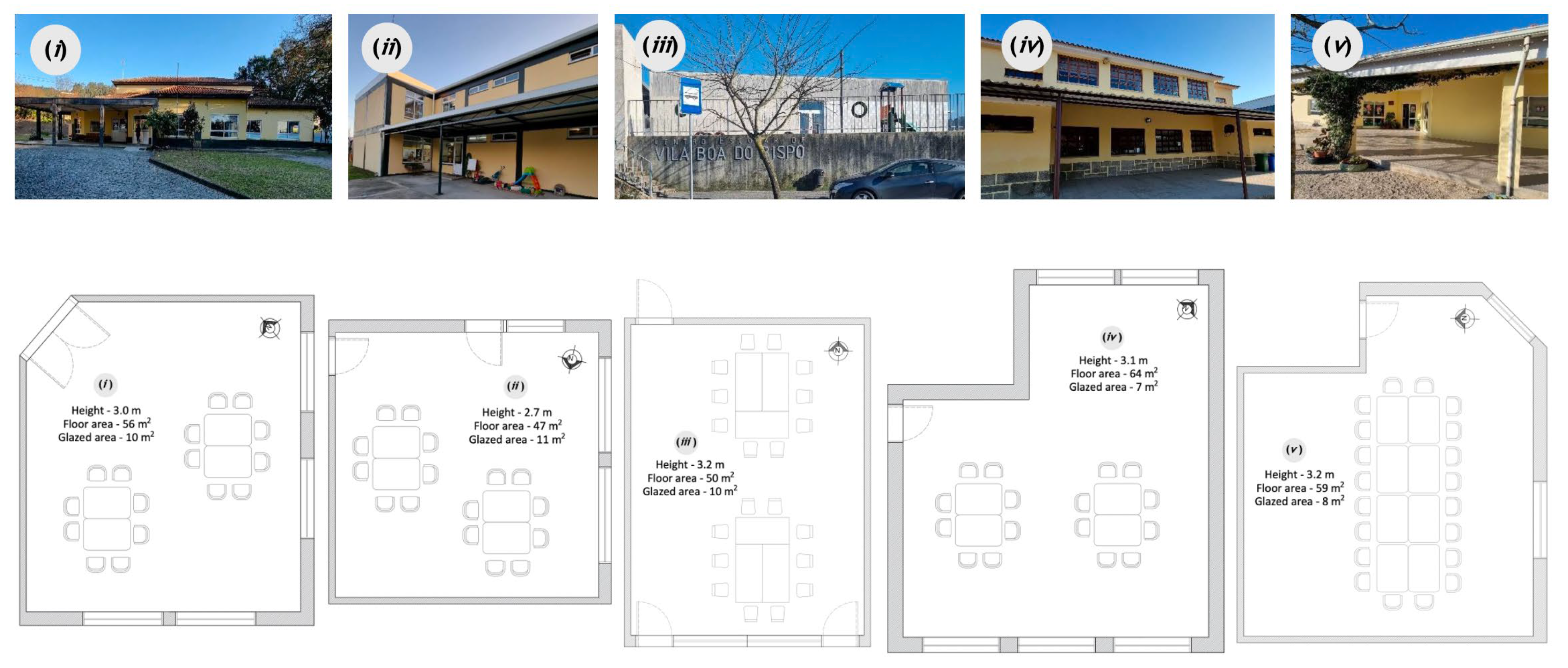
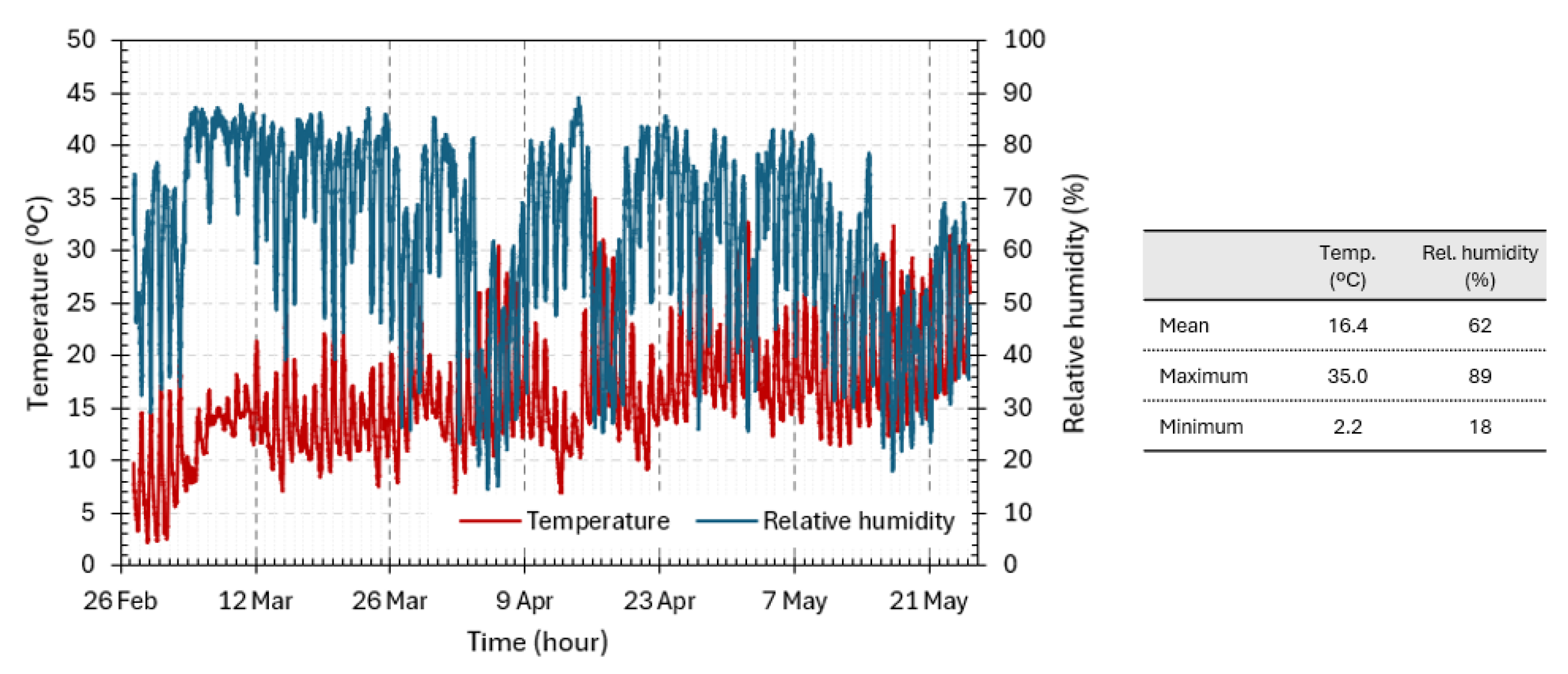
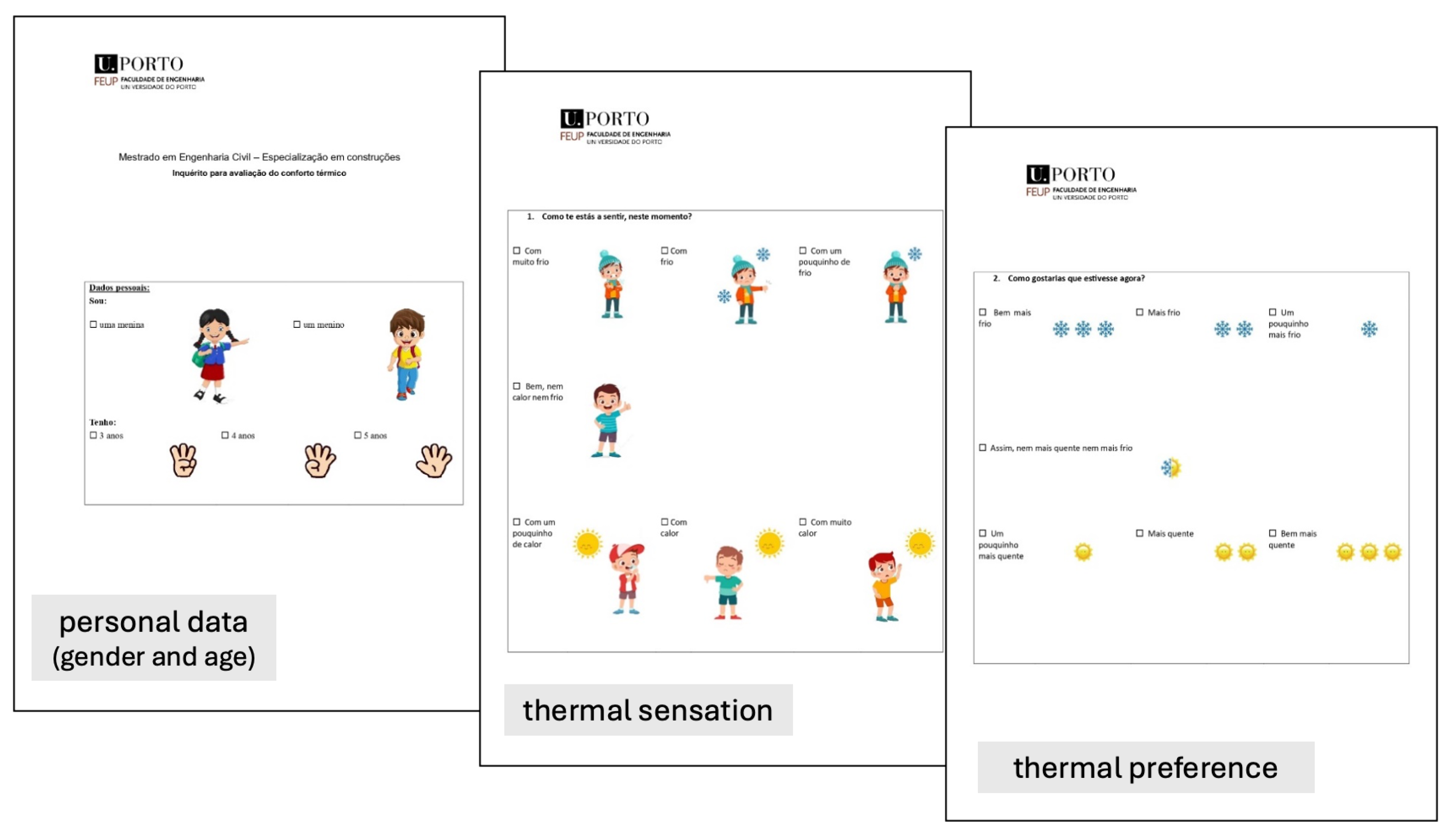
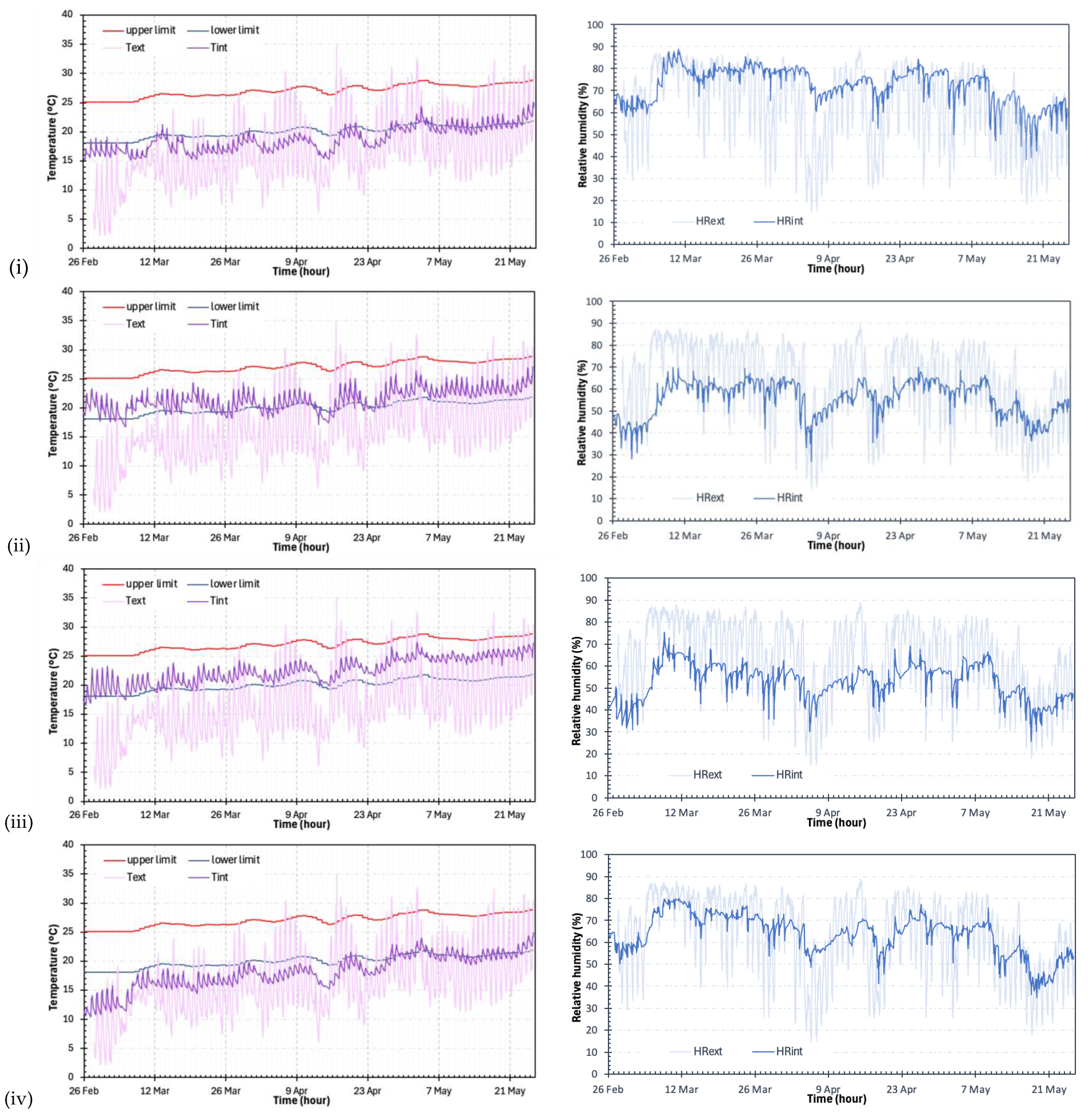

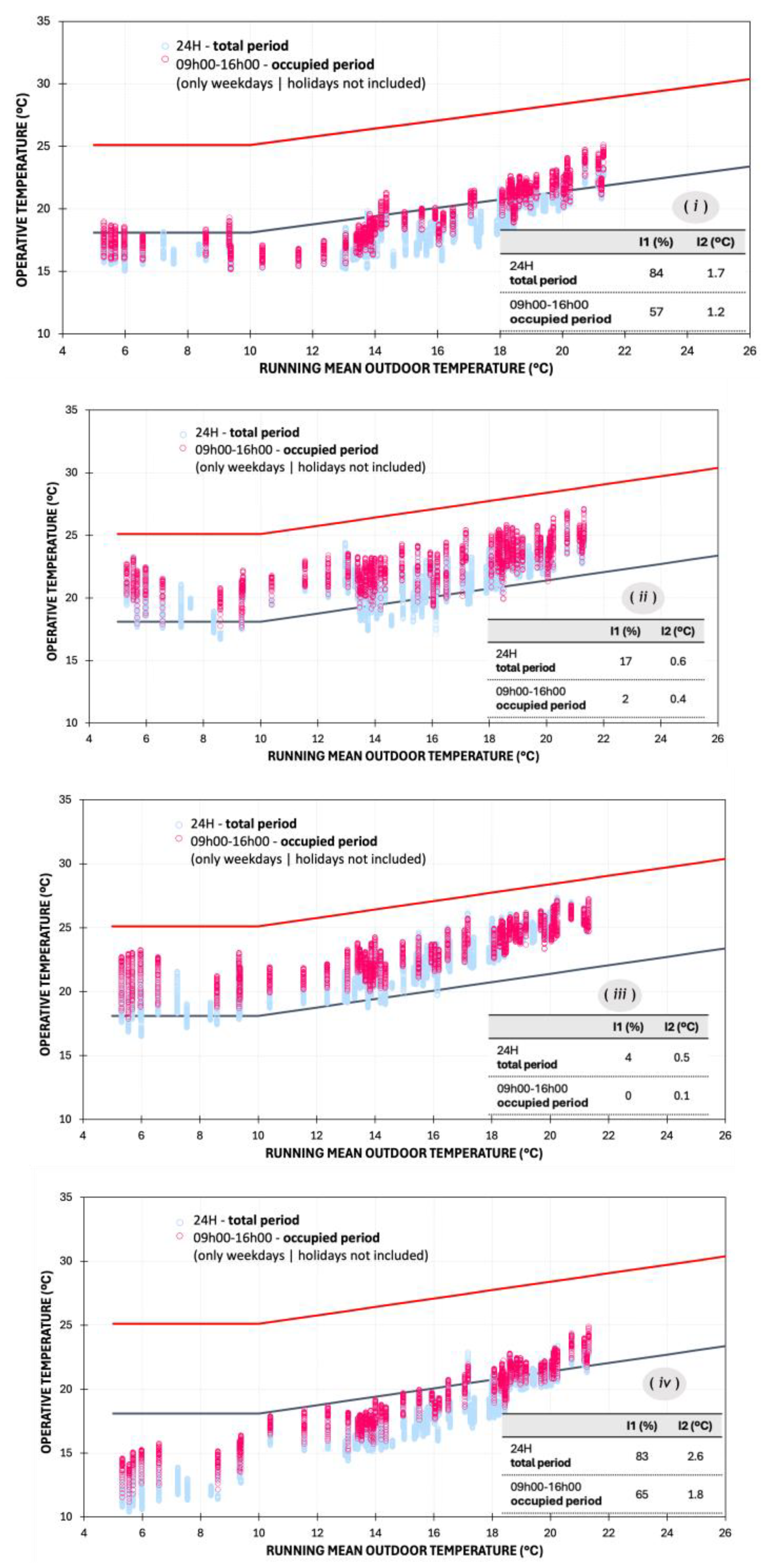
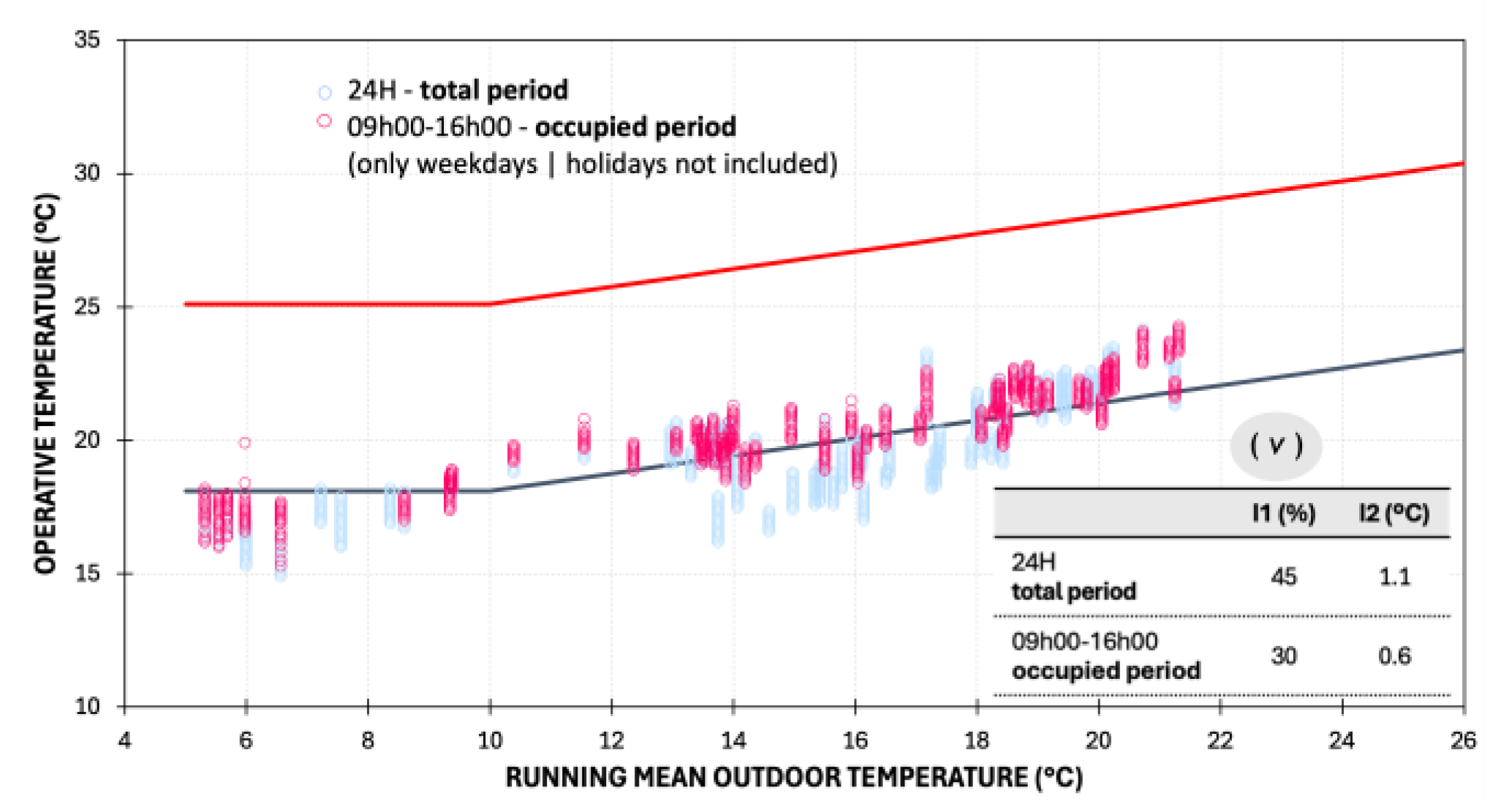
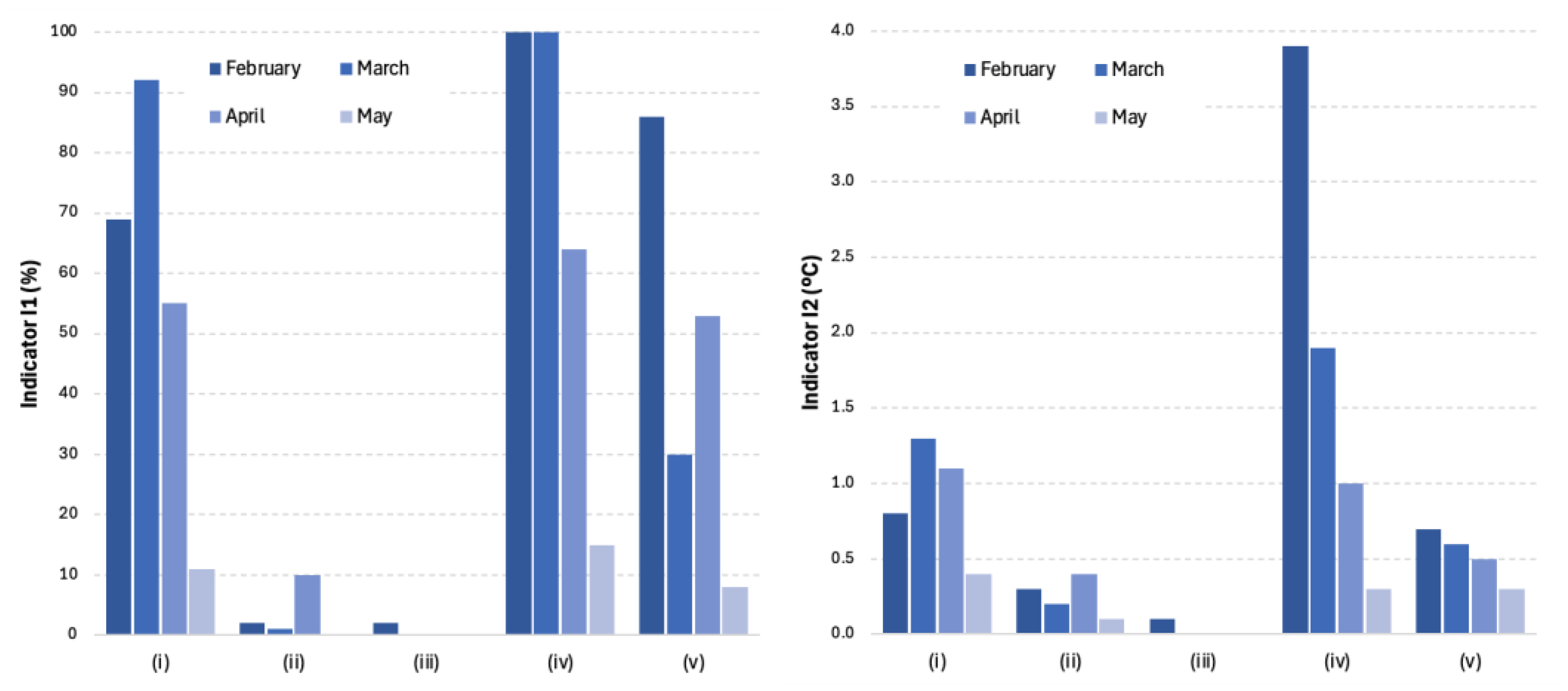
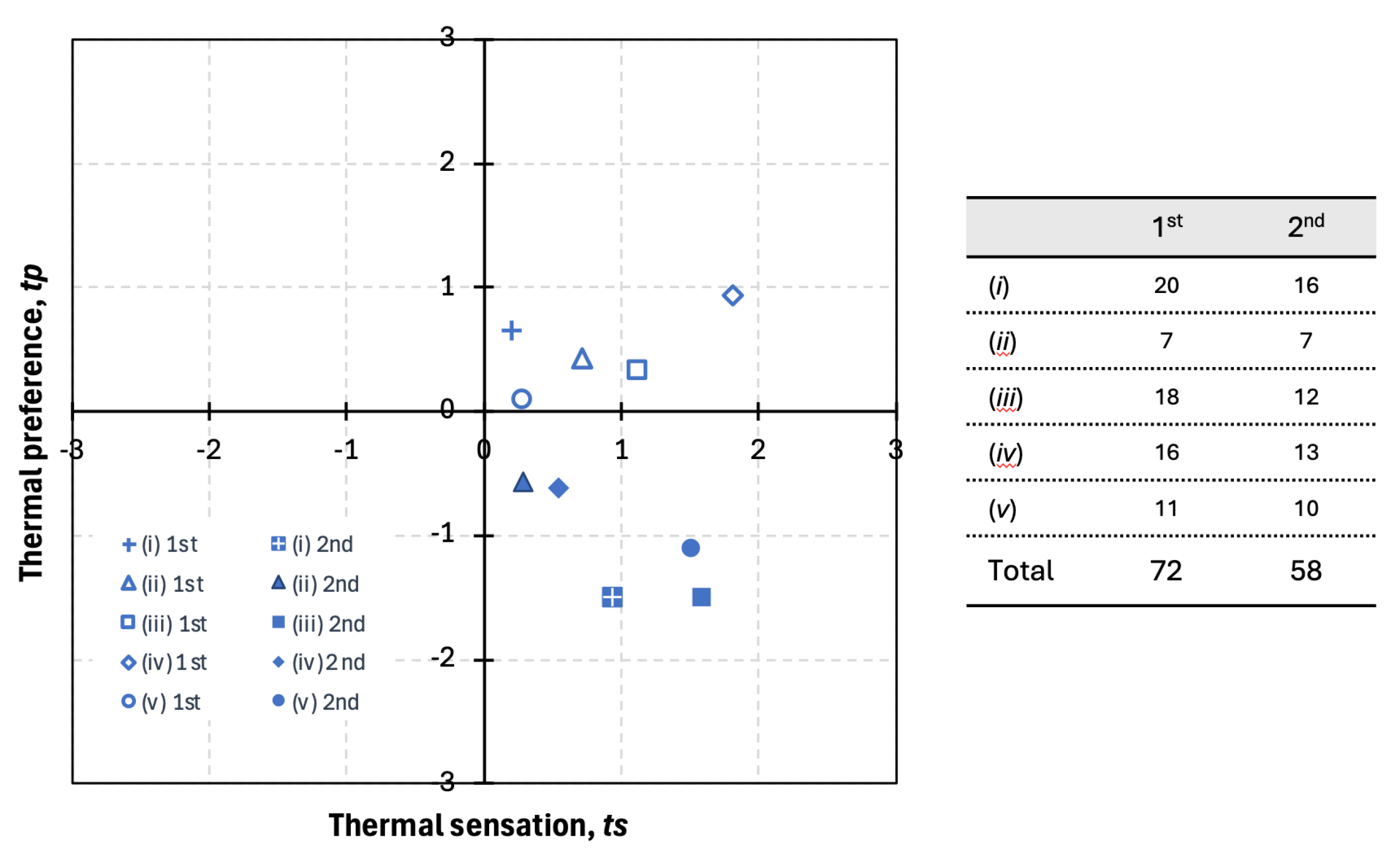
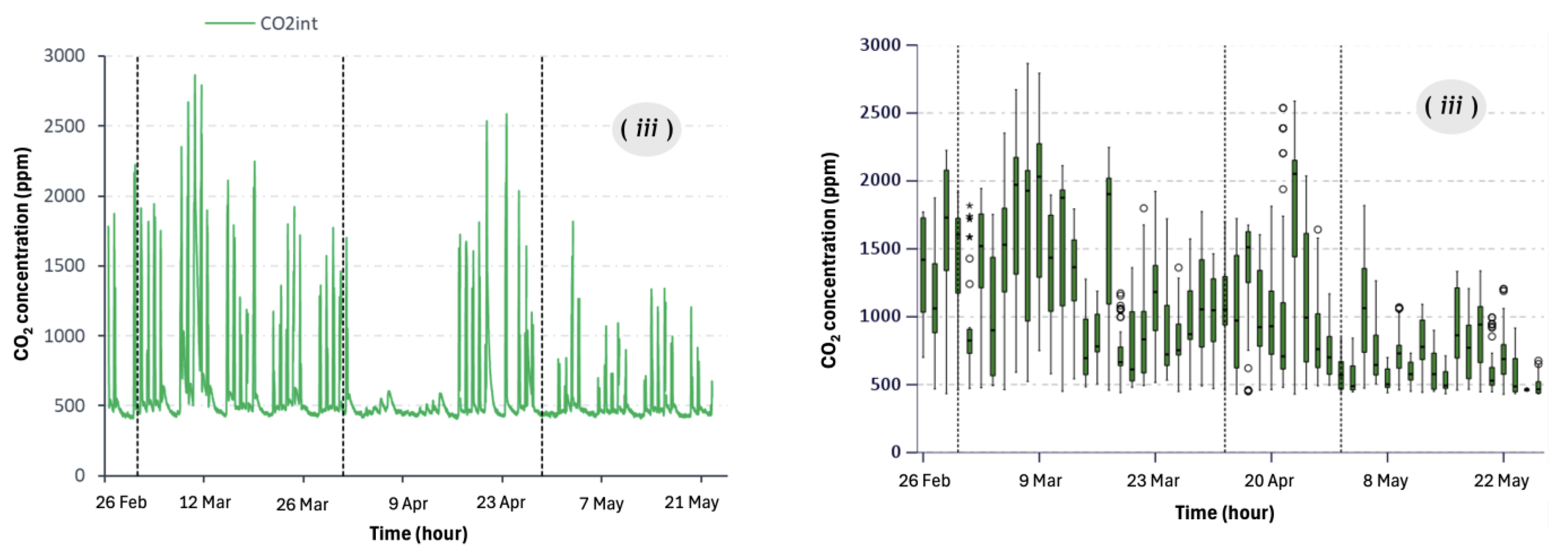
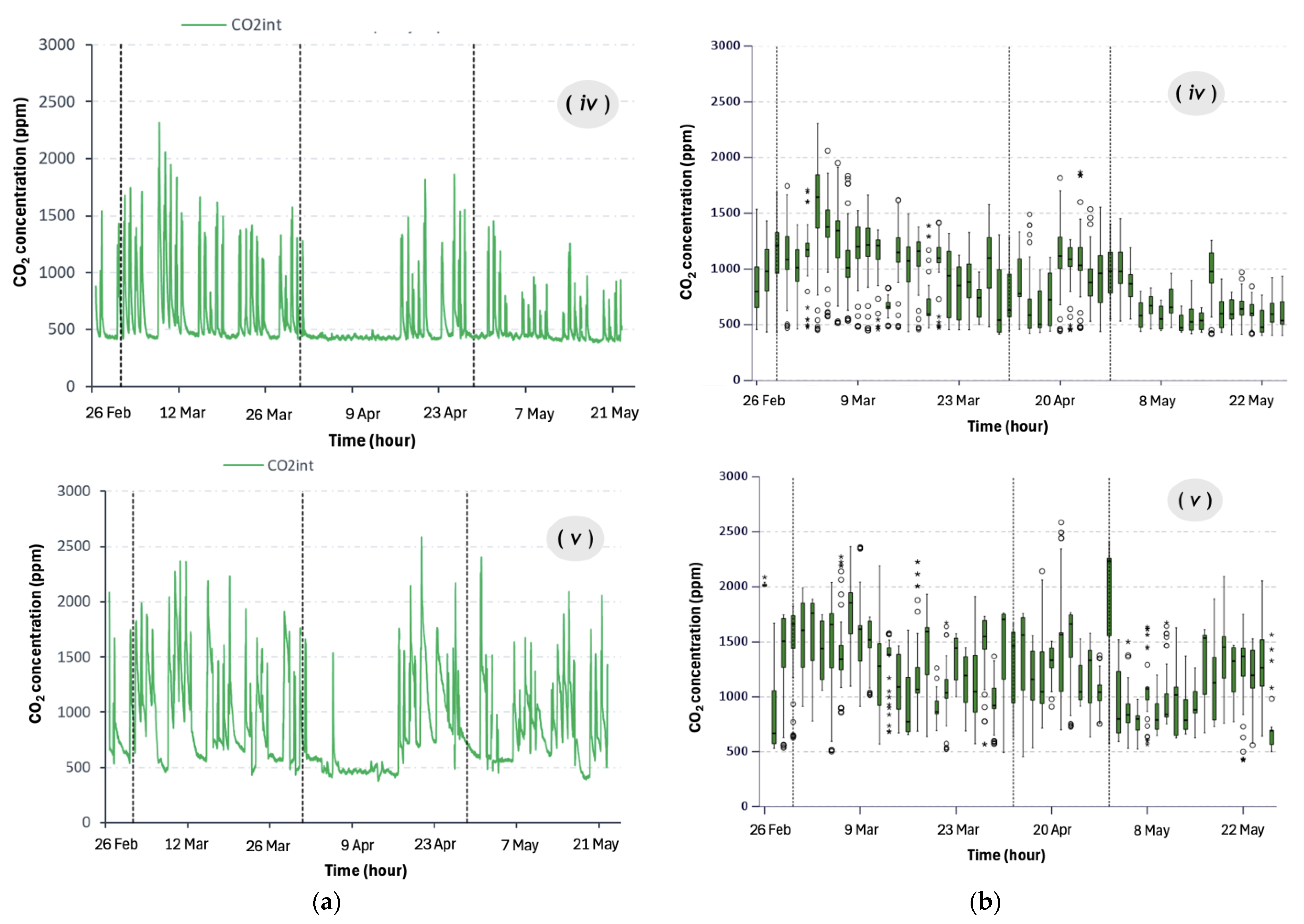

| Kindergarten | Number of Students | Floor Area (m2) | Height (m) | Glazed Area (m2) | Aglazed/Afloor (%) | |||
|---|---|---|---|---|---|---|---|---|
| SE | S | SW | NW | |||||
| (i) | 20 | 56 | 3.0 | 5 | - | 5 | - | 18 |
| (ii) | 7 | 47 | 2.7 | 1 | - | 9 | - | 21 |
| (iii) | 20 | 50 | 3.2 | - | 10 | - | - | 20 |
| (iv) | 19 | 64 | 3.1 | 3 | - | - | 4 | 11 |
| (v) | 20 | 59 | 3.2 | - | 8 | - | - | 14 |
| (i) | (ii) | (iii) | (iv) | (v) | |
|---|---|---|---|---|---|
| Construction period | 1990s | 1980s | 2012 | 1970s | 1990s |
| Exterior walls | double-layer brick (33 cm) with insulation | double-layer brick (32 cm) | double-layer brick (30 cm) with insulation | single-layer brick (39 cm) | double-layer brick (35 cm) with insulation |
| Roof | pitched with insulation | flat | flat with insulation | pitched | pitched with insulation |
| Windows | double glazing and aluminum frames | double glazing and aluminum frames | double glazing and aluminum frames | double glazing and wood frames | double glazing and aluminum frames |
| Shading | opaque curtains | opaque curtains | opaque curtains and fixed exterior horizontal shade | wooden slatted blinds | opaque curtains |
| Ventilation | natural (infiltration and window opening) | natural (infiltration and window opening) | mechanical | natural (infiltration and window opening) | natural (infiltration and window opening) |
| Heating | individual heating devices | individual heating devices | centralized | individual heating devices | individual heating devices |
| Text (°C) | Tint (°C) | ||||||
|---|---|---|---|---|---|---|---|
| (i) | (ii) | (iii) | (iv) | (v) | |||
| 1st phase | Mean | 17.1 | 18.5 | 21.0 | 23.2 | 18.7 | 19.7 |
| Maximum | 31.1 | 21.5 | 25.1 | 25.8 | 22.0 | 22.4 | |
| Minimum | 9.1 | 17.2 | 19.3 | 21.8 | 17.0 | 18.5 | |
| 2nd phase | Mean | 22.9 | 23.6 | 25.0 | 26.1 | 23.4 | 23.6 |
| Maximum | 30.5 | 25.1 | 27.3 | 27.4 | 25.2 | 24.3 | |
| Minimum | 18.3 | 22.6 | 24.1 | 24.7 | 22.6 | 23.3 | |
Disclaimer/Publisher’s Note: The statements, opinions and data contained in all publications are solely those of the individual author(s) and contributor(s) and not of MDPI and/or the editor(s). MDPI and/or the editor(s) disclaim responsibility for any injury to people or property resulting from any ideas, methods, instructions or products referred to in the content. |
© 2024 by the authors. Licensee MDPI, Basel, Switzerland. This article is an open access article distributed under the terms and conditions of the Creative Commons Attribution (CC BY) license (https://creativecommons.org/licenses/by/4.0/).
Share and Cite
Barreira, E.; Almeida, R.M.S.F.; Guimarães, J. Indoor Environment in Kindergartens Located in the North of Portugal: Evaluation of Thermal Comfort and Carbon Dioxide Concentration. Buildings 2024, 14, 3360. https://doi.org/10.3390/buildings14113360
Barreira E, Almeida RMSF, Guimarães J. Indoor Environment in Kindergartens Located in the North of Portugal: Evaluation of Thermal Comfort and Carbon Dioxide Concentration. Buildings. 2024; 14(11):3360. https://doi.org/10.3390/buildings14113360
Chicago/Turabian StyleBarreira, Eva, Ricardo M. S. F. Almeida, and Joana Guimarães. 2024. "Indoor Environment in Kindergartens Located in the North of Portugal: Evaluation of Thermal Comfort and Carbon Dioxide Concentration" Buildings 14, no. 11: 3360. https://doi.org/10.3390/buildings14113360
APA StyleBarreira, E., Almeida, R. M. S. F., & Guimarães, J. (2024). Indoor Environment in Kindergartens Located in the North of Portugal: Evaluation of Thermal Comfort and Carbon Dioxide Concentration. Buildings, 14(11), 3360. https://doi.org/10.3390/buildings14113360








